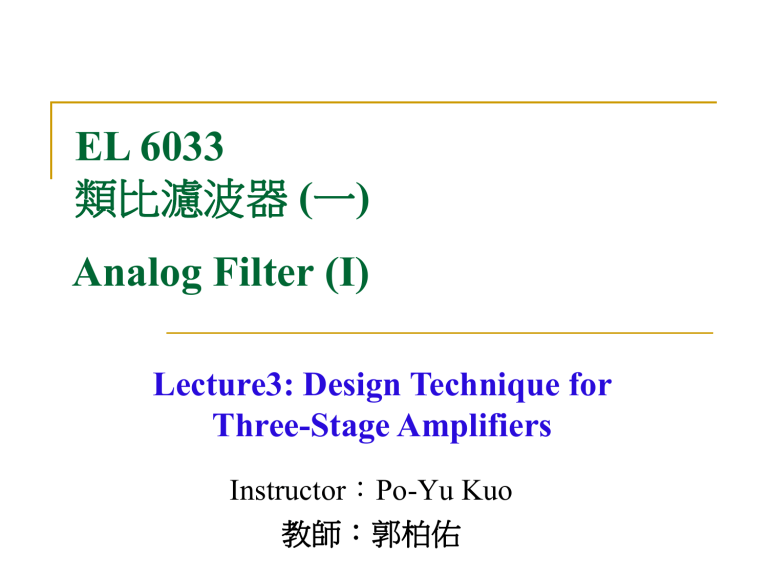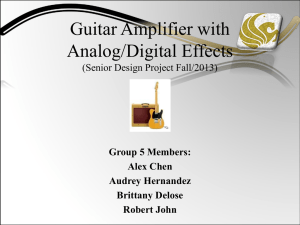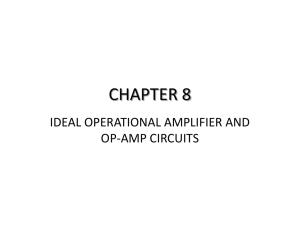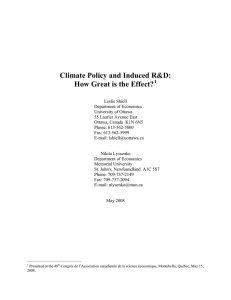Hybrid-π Model

EL 6033
類比濾波器 ( 一 )
Analog Filter (I)
Lecture3: Design Technique for
Three-Stage Amplifiers
Instructor : Po-Yu Kuo
教師:郭柏佑
Outline
Introduction
Structure and Hybridπ Model
Stability Criteria
Circuit Structure
2
Why We Need Three-Stage Amplifier?
Continuous device scaling in CMOS technologies lead to decrease in supply voltage
High dc gain of the amplifier is required for controlling different power management integrated circuits such as low-dropout regulators and switched-capacitor dc/dc regulators to maintain the constant of the output voltage irrespective to the change of the supply voltage and load current.
3
High DC Gain in Low-Voltage Condition
Cascode approach: enhance dc gain by stacking up transistors vertically by increasing effective output resistance (X)
Cascade approach: enhance dc gain by increasing the number of gain stages horizontally (Multistage Amplifier)
Gain of single-stage amplifier [g m r o
]~20-40dB
Gain of two-stage amplifier [(g m r o
) 2 ]~40-80dB
Gain of three-stage amplifier [(g m r o
) 3 ]~80-120dB, which is sufficient for most applications
4
Challenge and Soultion
Three-stage amplifier has at least 3 low-frequency poles (each gain stage contributes 1 low-frequency pole)
Inherent stability problem
General approach: Sacrifice UGF for achieving stability
Nested-Miller compensation (NMC) is a classical approach for stabilizing the three-stage amplifier
5
Structure of NMC
DC gain=(-A
1
)x(A
2
)x(-A
3
)=(-g m1 r
1
) x(g m2 r
2
) x(-g mL r
L
)
Pole splitting is realized by both
Both C m1 and C m2 realize negative local feedback loops for stability
6
Hybrid-π Model
Structure
Hybridπ Model
Hybrid- model is used to derive small-signal transfer function (V o
/V in
)
7
Transfer Function
Assuming g m3
>> g m2 and C
L
, C m1
, C m2
>> C
1
, C
2
A v
( s )
V o
( s )
V in
( s )
1
g m 1 g m 2 g mL r
1 r
2 r
L
1
sC m 1 g m 2 g mL r
1 r
2 r
L s
C m 2
1
g mL s
C m 2 g m 2 s
2
C m 1
C m 2 g m 2 g mL s
2
C
L
C m 2 g m 2 g mL
NMC has 3 poles and 2 zeros
UGF = DC gain p
-3dB
= g m1
/C m1
8
Review on Quadratic Polynomial (1)
When the denominator of the transfer function has a quadratic polynomial as
D ( s )
1
s
Qw
0 s
2
w
0
2
The amplifier has either 2 separate poles (real roots of D(s)) or 1 complex pole pair (complex roots)
Complex pole pair exists if
1
Qw
0
2
4 w
0
2
0
Q
1
2
9
Review on Quadratic Polynomial (2)
The complex pole can be expressed using the s-plane:
The position of poles: p
2 , 3
w
0
2 poles are located at p
2 , 3
w
0
2 Q
j
w
0
2 Q
4 Q
2
1
p
2 , 3
w
0
2
j w
0
2
10
Stability Criteria
Stability criteria are for designing C m1
, C m2
, g m1
, g m2
, g mL to optimize unity-gain frequency (UGF) and phase margin (PM)
Stability criteria:
Butterworth unity-feedback response for placing the second and third non-dominant pole
Butterworth unity-feedback response is a systematic approach that greatly reduces the design time of the
NMC amplifier
11
Butterworth Unity-Feedback Response(1)
Assume zeros are negligible
1 dominant pole (p
-3dB
) located within the passband, and 2 nondominant poles (p
2,3
) are complex and |p
2,3
| is beyond the UGF of the amplifier
Butterworth unity-feedback response ensures the Q value of p
2,3 is
1 / 2
PM of the amplifier
PM
180
tan
1
UGF p
3 dB
tan
1
Q 1
UGF
UGF
/ p
2 , 3
/ p
2 , 3
2
60
where |p
2,3
| =
( g m 2 g m 3
/ C
L
C m 2
)
12
Butterworth Unity-Feedback Response(2)
13
Circuit Implementation
Schematic of a three-stage NMC amplifier
14
Structure of NMC with Null Resistor (NMCNR)
Structure
Hybridπ Model
15
Transfer function
Assume g mL
>> g m2
, C
L
, C m1
, C m2
>> C
1
, C
2
A v
( s )
V o
( s )
V in
( s )
g m 1 g m 2 g mL r
1 r
2 r
L
1
s
C m 1
R m
C m 2
( R m
1 / g mL
)
s
2
1
sC m 1 g m 2 g mL r
1 r
2 r
L
1
s
C m 2 g m 2
s
2
C m 1
C m 2
( g mL
R m
C
L
C m 2 g m 2 g mL
g m 2 g mL
1
g m 1 g m 2 g mL r
1 r
2 r
L
1
s sC m 1 g m 2 g mL r
1 r
2 r
L
1
s
C m 2 g m 2
C m 1 g mL
s
2
C
L
C m 2 g m 2 g mL
if R m
1 g mL
1 )
16
Structure of Nested Gm-C Compensation (NGCC)
Structure
Hybridπ Model
17
Transfer function
Assume C
L
, C m1
, C m2
>> C
1
, C
2
A v
( s )
V o
( s )
V in
( s )
g m 1 g m 2 g mL r
1 r
2 r
L
1
1
s sC m 1 g m 2 g mL r
1 r
2 r
L
C m 2
( g mf
1
s
2
g m 2 g mL g m 2
)
C m 2
( g mf 2
s
2 g m 2 g m 2 g mL
C m 1
C m 2
( g mf 1 g m 1 g m 2 g
g m 1
) mL
g mL
)
s
2
C g
L m 2
C g m 2 mL
1
g m 1 g m 2 g mL r
1 r
2 r
L sC m 1 g m 2 g mL r
1 r
2 r
L
1
s
C m 2 g m 2
s
2
C
L
C m 2 g m 2 g mL
if g mf 1
g m 1
& g mf 2
g m 2
18








